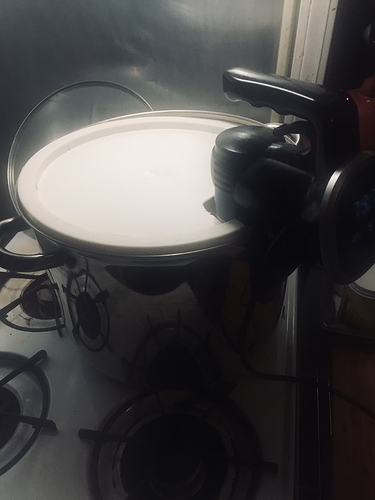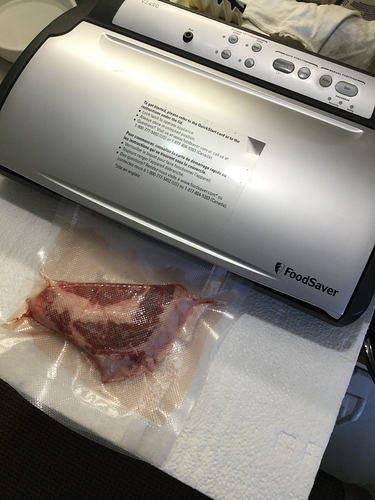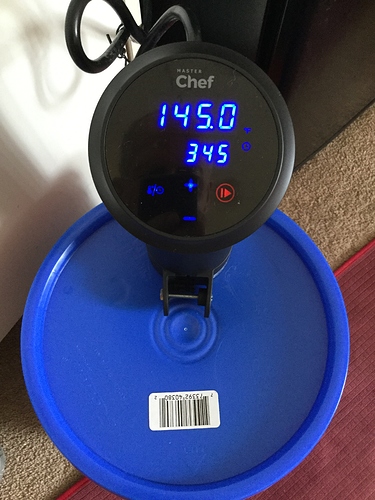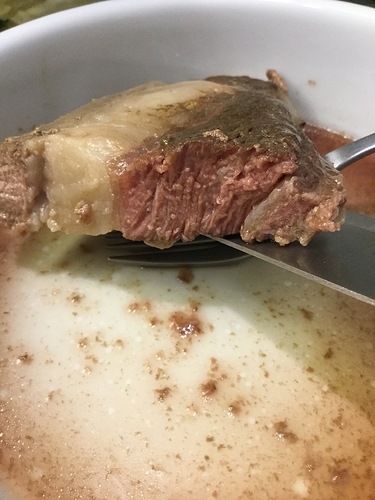I think my VPCOK is about that size. I saw a couple reviewers complain about this, but I don’t see any problem with it.
Ya’ know, regardless of what material your water vessel is made of, your meat pouch is going to be whatever type of plastic you choose. I’ve heard that “all plastic bags”, including Ziplocs are completely safe, because of the relatively low heat used for SV cooking. Of course personally speaking, cancer is the last thing I worry about anyway, in spite of the fact I’m most likely to get it. (that’s a whole other story)
Mike's Excellent Sous Vide Adventure 🥩
That wasn’t my concern, Chris. I thought I’m probably going to be cooking at 150-160℉ and that might be too hot for the plastic. These coolers are designed to hold ice water not hot water. Maybe my concern is unfounded and the plastic in these things could hold boiling water with no problem. I’ll research that a bit and see what I can find out.
PS [edit]: An aluminum or stainless pot can be heated on the stove.
Their used to be this old skit, way back in the day on Santurday Night Live with Gilda Radner, where she would get off onto some big, crazy rant… and they would finally stop her, and tell her, OK, but that’s not what this is about… To which she would reply, “Nevermind”  lol
lol
But anyway, as far as bags melting goes, unless you want to SV something really hot (vegetables maybe ?) you wont have any problem…
When I first saw this, I thought, “I’ve never heard of that!”, so I spent the last half hour and some change looking for user reports or other evidence of the plastic in a cooler melting. I didn’t find anything. I found several people asking if their cooler could hold hot drinks, but those were mostly about those drink containers places like Igloo sells.
Plastics used in commercial products ordinarily melt well above the boiling point of water, like 300F or above, and the only things I came across were concerns about chemicals coming out of the plastic and ending up in the hot beverage. If your sous vide meal contacts the hot water, things have gone very wrong - that happened to me once.
@CFLBob I investigated as well. About all I could find pretty much matches what you said. Except the melt temp, which apparently can vary a lot depending on the specific plastic. Some plastics can lose structural integrity not much above the boiling point of water. I should mention, however, that one guy reported interior layer distortion in a Coleman cooler with 180℉ water. I looked mostly at folks using the beer coolers to make beer. Since they’re actually dumping boiling or near-boiling beer wort into the coolers, the major concern is chemical leaching from the plastic into the beer. But no one has heard a single report of anyone getting poisoned by contaminated home brew from a Coleman or Igloo beer cooler. The guy who managed to deform his cooler might simply have had a cooler outlier.
I bought one of these at Walmart today for $2.98, plus another $1.53 for a matching lid:
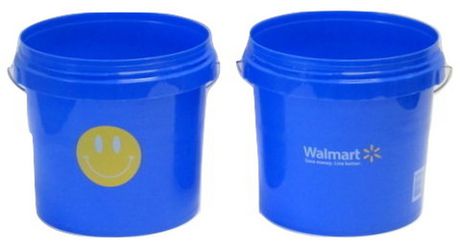
I have used these hard plastic pails for many purposes for years, including filling them with very hot water with no apparent damage. The 2-gallon bucket looks to be about the right size for the sous vide cooker I just purchased. I also like it being round rather than rectangular as I think the water circulation will be better.
Anyway, I’m going to drill a hole in the lid for the sous vide cooker as soon as I get a chance.
Sous vide?
Considering a Sous Vide machine
Sous vide?
Need fish cooking advice
I removed the spring clip from the cooker without damaging anything. This required removing a slightly counter sunk ‘tri wing’ screw of all things. I managed to extract it without having to purchase the dedicated screw driver. I then drilled out the bucket lid. This puppy is ready to hunt!
Considering a Sous Vide machine
Sous vide?
Sous vide?
Need fish cooking advice
What is unique about sous vide? From what I’ve learned so far, it’s not the slow cooking because other methods utilize slow cooking. It’s not low temps because other methods utilize low temps. It’s not even the water bath because if you ever hard boiled or poached an egg you utilized a water bath. No, what’s truly unique about sous vide is just what its name says: under vacuum. It’s the vacuum sealing to remove as much air as possible that makes sous vide unique.
I understand that sous vide means “under vacuum”. However, I have never vacuum packed my stuff. The true value that cooking sous vide delivers for me is that the controller can maintain the temperature so precisely for an indefinite period, and that the water can transfer heat to the item being cooked uniformly.
Nice and welcome to the wild world of sous vide!
What do you have planned for your first few cooks?
I dunno’ Michael. NO other method offers such precision control of temps. A Crock Pot is not even close to the same thing. You have to add water (dilute) your recipe, just to keep everything under liquids.
Poaching an egg is a different thing, as the shell keeps everything inside, with no diluting of the egg.
I know there are some guys who think that vacuum sealing with a machine is important, but honestly, I just don’t see it. There is no way you could make meat any more tender (heck, I can turn it into mush if I wanted to… or should I say, by accident) or any more juicy… I’ve actually made beef that I wish was just a touch drier, as it would not even soak up any Au Jus sauce…
Now, I do kind of pride myself at using a straw to vacuum my freezer Ziplocs quite well. Not as super vacuumed as a machine would do, I’m sure. But certainly 95+% as well. Put it this way, my bags never try to float.
In fact, I keep straws around, and even when putting away leftovers and such, I always vacuum my Ziplocs… Have to be careful with my Keto bread though, as I can easily crush it into a wad  lol
lol
@Jamboribs Steve, unfortunately I just finished day 3 of 7 consecutive so not conducive to learning exactly how to use my new cooker. I have some of this still frozen. I might take a piece out of the freezer tomorrow evening to let it thaw overnight in the fridge. Then I could bag and start to cook it after I get home from work around 1pm Sunday for supper.
@FishChris Chris, a lot of folks seem to agree with you about the vacuum. But my feeling is the French didn’t name it ‘under vacuum’ for nothing much. Since I already have the vacuum bagger and know how to use the thing, I’m going to try it. I do know how to get the air out of a Ziplock bag, although I didn’t use your straw method which I bet probably works better than simply letting water compress the bag. I have plenty of Ziplocks so the next time I use one I’ll try the straw method. I think that would be way safer with a very wet piece of meat rather than the vacuum bagger. Don’t want to suck any liquid into it!
Also, I think you’re right about temperature control. I think it’s much easier to control the temp of a water bath than circulating air, for example. Even so, I still think the vacuum is what makes sous vide unique. And ‘vacuum’ does not necessitate a machine. If the object of the exercise is simply to remove as much air as possible so the meat is exposed uniformly to the water bath, a machine will do a better job, but your straw method is adequate as is simply letting the water bath force out the air. I think it’s probably more important to make sure no wrinkles form in the bag directly over the meat.
…and you know Michael, you could actually submerge your Ziploc with meat, bottom first, AND use the straw method at the same time, and that might work better yet.
But anyway, the way I see it, there are really only three parameters to consider when cooking SV… 1) how well done 2) how tender and 3) how evenly cooked…
And so if you can nail all 3 of these things consistently (which I am starting to now) using Ziplocs, I just can’t see any advantage to vacuum sealing.
Like I say, at this point, I’m starting to play around with different marinades and seasonings, because I have most of my meats completely dialed in for doneness and tenderness. and so on that front, results might still vary 
First test run tonight with empty bucket of water. It was pretty easy to set the temp and time. I only set the temp to 130℉ but I can smell the plastic bucket. Hopefully, it will degas and that will be the end of it. Not overwhelming or anything, just noticeable.
Nice touch, the timer didn’t start until the water reached 130. Took about 15 minutes to get there.
Nice AAA Angus rib steaks. If you like a medium steak try a sprinkle of salt & pepper, sous vide at 134* for 1 1/2 - 2 hours. You can simply eat it when it is finished or give it a quick sear to add some colour. Sous vide is very forgiving. I am a huge fan of the Foodsaver vacuum bags so that is how I seal my meats. I ruined a nice piece of meat once using the Ziploc bag method, never again.
Enjoy!
Posting this for reference:
I used the same technique and still do if I take my pod on vacation to visit people. It’s close enough to vacuum but a food vac has advantages.
Here’s my setup Michael
It’s a 16 qt stock pot with a bucket lid that fits perfectly in the rim. I like using a metal pot because I can preheat the water on the burner to get cooking fast. I have a couple smaller vessels that I can do a steak or a few chicken thighs in about a gallon of water. 
2019-10-06 Today’s endeavour:
Note, I did what I could call a ‘soft vacuum’. I vacuumed the bag until the meat was compressed somewhat, then stopped vacuuming for a couple seconds before sealing. This allowed a small amount of air back into the bag. Notice liquid from the meat has migrated into the air channels of the bag. This is a FoodSaver bag.
145℉ for 4.0 hours, 15 minutes in.
Looks like about a 1/4 - 1/2 teaspoon of liquid in the bag. This was a very moist piece of meat with about 50% fat, so not much left the meat. Next time I’ll try what I could call a ‘hard vacuum’ to see if it loses any less liquid.
The payoff! Note the fat is translucent/opaque and was quite easy to chew, although slightly tougher than the meat itself. Overall not a bad first attempt. I think next time I’ll go for 150℉.
Sous vide?
Sous vide?
Considering a Sous Vide machine
David, that’s a nice set up. I am also attracted to using a metal pail in order to be able to preheat on the stove. I went with the plastic bucket mostly because I didn’t want to wait until I got around to making a hole in a metal lid. Although, if I could locate a bucket/pot with the correct diameter I could use the plastic lid like you. Thanks.
Good idea! I also thought that next time I’ll put a strip of paper towel above the meat in an attempt to minimize migration of liquid towards the open end of the bag during vacuuming.


